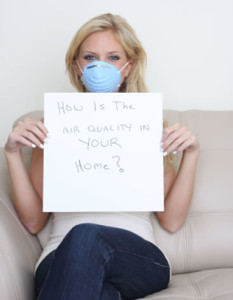 When most people think of pollution they think of outside smog, ozone, and haze. What they don’t think about or may not even know; however, indoor air pollution can actually be worse than outdoor air. Allergies, asthma, and other respiratory problems to in the most extreme cases lung cancer are linked to poor indoor air quality and indoor air pollutants.
When most people think of pollution they think of outside smog, ozone, and haze. What they don’t think about or may not even know; however, indoor air pollution can actually be worse than outdoor air. Allergies, asthma, and other respiratory problems to in the most extreme cases lung cancer are linked to poor indoor air quality and indoor air pollutants.
Homes today are built tighter with less air exchanges. The good part is it results in a more energy efficient house, while the bad part is it results in poor indoor air quality.
Some signs you may have an indoor air quality problems are: odors, noticeably stale or stuffy air, excessive humidity or lack of air movement. If you see mold or mildew, damaged flue pipes or chimneys, or dirty or faulty heating, venting, and air conditioning systems then you may have a problem or potential problem.
Another sign are health symptoms. If you have consistent allergies, stuffy nose, headaches, sinus issues, or coughs and feel noticeably better when you are outside, then you might have what is known as sick building syndrome. Sick building syndrome is when a building’s environment is making you sick.
The good thing is indoor air quality is something you can control and manage. Here are some ways to improve the air quality in your home.
Eliminate as many toxins as possible
Cleaners, aerosol cans, certain air fresheners, and other household chemicals release toxins into the air. Try to avoid putting toxins into the air. Cigarette smoke and wood burning fires also put harmful toxins into the air. Work on avoiding contributing to the problem. That goes for dust and animal dander as well. Cleaning and dusting regularly as well as installing an air purifier can help with this. Opening the windows when you clean will help get rid of allergens, dust particles, and toxins.
Keep a healthy level of humidity
Researchers say 50% relative humidity is the best case scenario for indoor air. A high level of humidity is bad for indoor air quality and fosters mold, mildew, and rot. Dust mites, insects, pests, and cockroaches all thrive in humid environments. Controlling moisture is a great way to avoid these issues. You may want to purchase a dehumidifier and look for any leaks or other problems creating high levels of moisture.
Waterproof your basement of crawlspace
Part of controlling moisture is creating a healthy, dry environment below-grade. Make sure you never have standing water, leaks, or puddles in your basement or crawlspace. This moisture will travel upstairs and create the problems we were just mentioning. Mold and mildew doesn’t stay in one place. If it is present and let unattended it will spread and wreak havoc on the house and your health. Make sure the foundation is free some cracks or gaps. This will let in water and soil gases.
Test for radon
Speaking of soil gases, the number one most harmful soil gas is radon. Radon is a natural occurring gas from decaying uranium in the soil. It is the number two cause of lung cancer and the leading cause for nonsmokers. It has been found in every state and in every soil type. Because it is odorless, tasteless and invisible the only way to know if you have harmful levels of radon is to test for it. It is very important to test for radon and if you find you have harmful levels of radon gas (if your radon level is 4 picocuries per liter (pCi/L) or higher) have a contractor install a radon mitigation system to eliminate the problem.
Circulate
Maintain good fresh air with natural and mechanical air circulation. Like we said before our homes are tighter these days so we need to make it a point to circulate both with mechanical ventilating systems and by opening a window. Don’t forget to use the exhaust fan while you cook to avoid noxious vapors, grease, and smoke staying into the air.